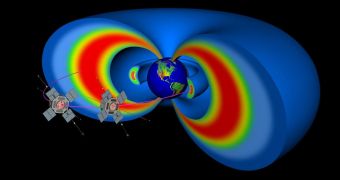Experts with the American space agency announce that spacecraft and science balloons are currently being prepared for launch, in a bid to better understand the Van Allen radiation belts around Earth.
The NASA Radiation Belt Space Probes (RBSP) mission is currently in its advanced stage of preparation, ahead of a planned 2012 launch date. Two identical spacecraft will launch to analyze the radiation patterns from outer space.
These belts are donut-shaped, and they surround the Earth one on top of the other. They are made up of protons and electrons, and their role is frankly still a matter of debate among planetary scientists.
However, what is known for sure about them is that the elementary particles they contain can easily damage electronics equipment aboard outgoing spacecraft and satellites, potentially causing millions of dollars-worth of damage.
Most of the particles in the Van Allen radiation belts are electrically-charged, which is why they are so important to understand. “Probably the most interesting thing to me about the radiation belts is how variable the region is,” says Robyn Millan.
The expert holds an appointment as a physicist at the Dartmouth College. “During geomagnetic storms, we see charged particles accelerated to really high, relativistic energies, traveling near the speed of light,” she tells Space.
“The number of these particles can increase by a factor of 1,000 in a day or less. We don't often think of Earth as being an efficient particle accelerator like exotic objects such as black holes or supernovae, but it is, and it is right in our own backyard, so we can really study the processes in detail,” the expert says.
In a bid to understand these variations – which can see the radiation belts literally disappear within a matter of days or less – NASA will be taking an integrated approach, combining readings obtained from the RBSP probes with data collected by science balloons that will be launched over Antarctica.
The twin spacecraft will be perched above the Earth's equator, and their goal will be to analyze how the charged particles in the Van Allen Belts are concentrated above magnetic lines at this location.
“One of RBSP's main challenges will be to differentiate between the hordes of theories that try to explain why the belts wax and wane over time,” explains expert David Sibeck.
The researcher, a project scientist for the RBSP at the NASA Goddard Space Flight Center (GSFC), in Greenbelt, Maryland, made the announcement in a recent press release.
“Even though the radiation belts were discovered in the late '50s, we have not had a recent dedicated space mission to study the detailed physics going on there – now we get to launch our balloons at just the right time, when a constellation of spacecraft are out there making high-quality science measurements,” Millan explains.

 14 DAY TRIAL //
14 DAY TRIAL //